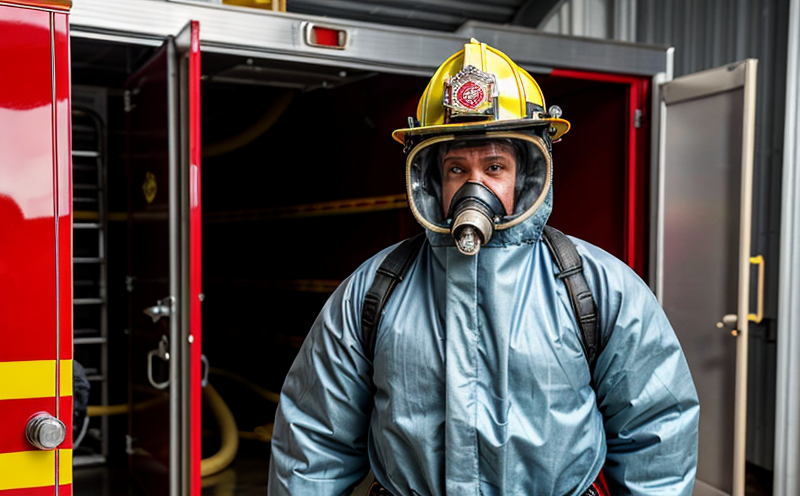Contamination Resistance Testing
In fire safety testing, contamination resistance is a critical factor that ensures firefighters' protective clothing and equipment can withstand hazardous environments. This testing evaluates how effectively the materials used in firefighting gear protect against chemical, biological, and particulate contaminants. The primary goal of this test is to ensure that firefighters remain safe and effective when exposed to dangerous conditions.
The process involves exposing a sample of firefighting gear to various types of contaminants under controlled laboratory conditions. The specimen preparation includes using real-world relevant materials such as synthetic oils, acids, and particulates that are commonly encountered in fireground scenarios. The testing apparatus typically consists of specialized chambers designed to simulate the environmental pressures firefighters face.
Acceptance criteria for this test vary based on international standards like ISO 26413:2019 and ASTM F1958-17, which specify that gear must maintain a minimum level of integrity after exposure. The testing apparatus used includes pressure chambers and filtration systems to replicate the conditions firefighters might encounter.
The significance of this test cannot be overstated in the fire safety sector. It ensures that the protective clothing and equipment meet stringent requirements for protecting firefighters from harmful contaminants, thereby enhancing their ability to perform their duties safely and effectively.
- Chemical Resistance: Ensuring the gear can withstand exposure to chemicals without degradation.
- Biological Contamination: Evaluating the protection against microorganisms that could be present in fireground scenarios.
- Particulate Matter: Testing for resistance to particulates like smoke and ash.
Through rigorous testing, laboratories can provide accurate data on how well a particular piece of equipment withstands contamination. This information is invaluable for quality managers, compliance officers, R&D engineers, and procurement teams looking to ensure the highest standards in firefighter safety gear.
The results of these tests are not just important for individual pieces of gear but also contribute to broader fire safety strategies. By understanding which materials perform best under various conditions, manufacturers can improve their products, leading to better protection for firefighters across the globe.
Benefits
- Enhanced Firefighter Safety: Ensures that protective clothing and equipment are effective in real-world scenarios.
- Informed Decision-Making: Provides data that helps quality managers, compliance officers, R&D engineers, and procurement teams make informed choices about gear selection.
- Better Gear Performance: Improves the performance of protective clothing by identifying materials that perform best under contamination conditions.
- Compliance with Standards: Ensures that products meet international standards like ISO 26413:2019 and ASTM F1958-17, enhancing trust in the market.
The benefits of contamination resistance testing extend beyond individual pieces of gear. By ensuring that firefighters have the best protection available, these tests contribute to a safer working environment for all personnel involved in fire safety operations.
Quality and Reliability Assurance
Contamination resistance testing plays a crucial role in maintaining quality and reliability assurance within the fire safety sector. The process involves meticulous specimen preparation, rigorous exposure to various contaminants, and strict adherence to international standards. This ensures that every piece of equipment tested is subjected to real-world conditions, providing reliable data for decision-making.
Quality managers rely on these tests to ensure their suppliers meet stringent quality control measures. Compliance officers use the results to verify that products comply with regulations and industry best practices. R&D engineers benefit from this testing by gaining insights into material performance under contamination scenarios, which can lead to innovations in gear design. Procurement teams find these tests invaluable for sourcing high-quality protective clothing and equipment.
The reliability of the testing process is further enhanced through repeatable procedures that ensure consistent results across multiple samples. This consistency is crucial for maintaining trust within the industry and ensuring that firefighters have dependable protection when they need it most.
Environmental and Sustainability Contributions
In addition to enhancing firefighter safety, contamination resistance testing contributes positively to environmental sustainability efforts. By identifying materials that perform best under contamination conditions, manufacturers can reduce waste by producing more durable gear that lasts longer in service. This reduces the frequency of replacements, lowering overall environmental impact.
The tests also encourage the use of eco-friendly materials and production processes, aligning with broader sustainability goals within the fire safety sector. By promoting sustainable practices, these tests help reduce the carbon footprint associated with firefighting equipment manufacturing and usage.
Furthermore, the results from contamination resistance testing can inform policies that promote the recycling or proper disposal of used protective clothing and equipment. This contributes to a more circular economy approach in the fire safety industry, ensuring that resources are used efficiently and responsibly.





